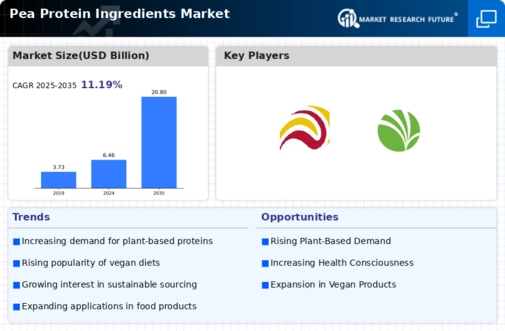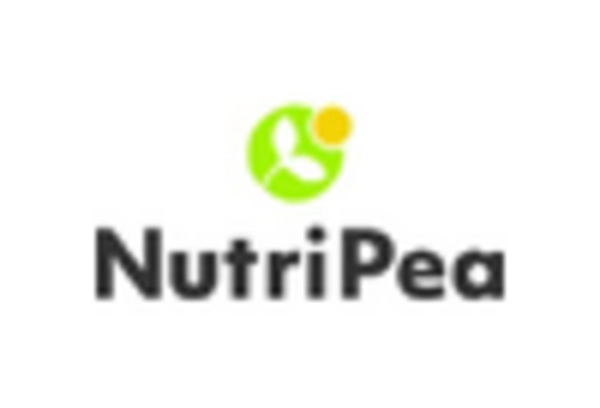-
EXECUTIVE SUMMARY
-
Market Attractiveness Analysis
- Global Pea Protein Ingredients Market, by
-
Type
-
Global Pea Protein Ingredients Market, by Application
-
Region
-
MARKET
-
INTRODUCTION
-
Definition
-
Scope of the Study
-
Global Pea Protein Ingredients Market, by
-
Market Structure
-
Key Buying Criteria
-
Macro Factor Indicator Analysis
-
RESEARCH METHODOLOGY
-
Research Process
-
Primary Research
-
Secondary
-
Research
-
Market Size Estimation
-
Forecast Model
-
List of Assumptions
-
MARKET DYNAMICS
-
Introduction
-
Drivers
-
Restraints
-
Opportunities
-
Challenges
-
MARKET FACTOR ANALYSIS
-
Value Chain Analysis
-
Supply Chain Analysis
-
Porter’s
- Bargaining Power of Suppliers
- Bargaining Power of Buyers
- Threat of New
- Intensity of Rivalry
-
Five Forces Model
-
Entrants
-
Threat of Substitutes
-
GLOBAL PEA PROTEIN INGREDIENTS MARKET, BY TYPE
-
Introduction
-
Isolates
- Isolates:
-
Market Estimates & Forecast, by Region/Country, 2023–2032
-
Concentrates
- Concentrates:
-
Market Estimates & Forecast, by Region/Country, 2023–2032
-
Textured
- Textured:
-
Market Estimates & Forecast, by Region/Country, 2023–2032
-
GLOBAL PEA PROTEIN INGREDIENTS
-
MARKET, BY APPLICATION
-
Introduction
-
Food & Beverages
-
Meat Substitutes
-
Bakery & Confectionery
-
by Country, 2023–2032
-
Country, 2023–2032
-
Forecast, by Country, 2023–2032
-
Food & Beverages: Market Estimates & Forecast, by Country,
-
Meat Substitutes: Market Estimates & Forecast, by Country,
-
Bakery & Confectionery: Market Estimates & Forecast,
-
Beverages
-
Beverages: Market Estimates & Forecast, by
-
Dietary Supplements
-
Dietary Supplements: Market Estimates &
-
Sweet & Savory Snacks
-
Sweet &
-
Savory Snacks: Market Estimates & Forecast, by Country, 2023–2032
-
Infant Nutrition
-
Infant Nutrition: Market Estimates & Forecast, by Country, 2023–2032
-
Others
-
Others:
-
Market Estimates & Forecast, by Country, 2023–2032
-
Animal Feed
- Animal Feed: Market
-
Estimates & Forecast, by Region/Country, 2023–2032
-
Others
- Others: Market Estimates
-
& Forecast, by Region/Country, 2023–2032
-
GLOBAL PEA PROTEIN INGREDIENTS MARKET, BY REGION
-
Introduction
-
North America
- Market Estimates
- Market Estimates & Forecast, by Application,
-
& Forecast, by Type, 2023–2032
-
Market Estimates & Forecast, by Country, 2023–2032
-
Forecast, by Type, 2023–2032
-
Canada
-
US
-
Market Estimates &
-
Market Estimates & Forecast, by Application,
-
Market Estimates & Forecast, by Type, 2023–2032
-
Forecast, by Application, 2023–2032
-
Market Estimates &
-
Mexico
-
Market Estimates & Forecast, by Type,
-
Market Estimates & Forecast, by Application, 2023–2032
-
Europe
- Market Estimates
- Market Estimates & Forecast, by Application,
-
& Forecast, by Type, 2023–2032
-
Market Estimates & Forecast, by Country, 2023–2032
-
& Forecast, by Type, 2023–2032
-
UK
-
Germany
-
Market Estimates
-
Market Estimates & Forecast, by Application,
-
Market Estimates & Forecast, by Type, 2023–2032
-
Forecast, by Application, 2023–2032
-
Market Estimates &
-
France
-
Market Estimates & Forecast, by Type,
-
Market Estimates & Forecast, by Application, 2023–2032
-
Estimates & Forecast, by Type, 2023–2032
-
Italy
-
Spain
-
Market
-
Market Estimates & Forecast, by Application,
-
Market Estimates & Forecast, by Type, 2023–2032
-
Forecast, by Application, 2023–2032
-
Market Estimates &
-
Rest of Europe
-
Market Estimates & Forecast, by Type,
-
Market Estimates & Forecast, by Application, 2023–2032
-
Asia-Pacific
- Market Estimates
- Market Estimates & Forecast, by Application,
-
& Forecast, by Type, 2023–2032
-
Market Estimates & Forecast, by Country, 2023–2032
-
& Forecast, by Type, 2023–2032
-
Japan
-
China
-
Market Estimates
-
Market Estimates & Forecast, by Application,
-
Market Estimates & Forecast, by Type, 2023–2032
-
Forecast, by Application, 2023–2032
-
Market Estimates &
-
India
-
Market Estimates & Forecast, by Type,
-
Market Estimates & Forecast, by Application, 2023–2032
-
New Zealand
-
Australia &
-
Market Estimates & Forecast, by Type, 2023–2032
-
Forecast, by Application, 2023–2032
-
Forecast, by Type, 2023–2032
-
Rest of the World
-
& Forecast, by Application, 2023–2032
-
South America
-
Market Estimates &
-
Rest of Asia-Pacific
-
Market Estimates &
-
Market Estimates & Forecast, by Application,
-
Market Estimates & Forecast, by Type, 2023–2032
-
Market Estimates
-
Market Estimates & Forecast, by Region,
-
Market Estimates & Forecast, by Type, 2023–2032
-
Forecast, by Application, 2023–2032
-
Market Estimates &
-
Middle East
-
Market Estimates & Forecast, by Type,
-
Market Estimates & Forecast, by Application, 2023–2032
-
Estimates & Forecast, by Type, 2023–2032
-
COMPETITIVE
-
LANDSCAPE
-
Introduction
-
Competitive Benchmarking
-
COMPANY PROFILES
-
Midland Company
-
Company Overview
-
Financial Overview
-
PLC
-
Company Overview
-
Financial Overview
-
Overview
-
Financial Overview
-
Company
-
Company Overview
-
Financial Overview
-
Ingredients Inc
-
Company Overview
-
Financial Overview
-
Warcoing SA
-
Company Overview
-
Financial Overview
-
Limited
-
Company Overview
-
Financial Overview
-
Corporation
-
Company Overview
-
Financial Overview
-
Frères S.A.
-
Private Label Supplements
-
Incorporated
-
Company Overview
-
Financial Overview
-
Overview
-
Financial Overview
-
Commodities Inc
-
Company Overview
-
Financial Overview
-
Solutions
-
Company Overview
-
Financial Overview
-
Inc.
-
Company Overview
-
Financial Overview
-
APPENDIX
-
References
-
List of Abbreviation
-
-
Africa
-
Market
-
Market Estimates & Forecast, by Application,
-
Development Share Analysis
-
Key Developments & Growth Strategies
-
Archer Daniels
- Products Offered
- Key Developments
- SWOT Analysis
- Key Strategies
-
Kerry Group
- Products Offered
- Key Developments
- SWOT Analysis
- Key Strategies
-
Cargill Incorporated
- Company
- Products Offered
- Key Developments
- SWOT Analysis
- Key Strategies
-
The Scoular
- Products Offered
- Key Developments
- SWOT Analysis
- Key Strategies
-
A & B
- Products Offered
- Key Developments
- SWOT Analysis
- Key Strategies
-
Cosucra Groupe
- Products Offered
- Key Developments
- SWOT Analysis
- Key Strategies
-
Nutri-Pea
- Products Offered
- Key Developments
- SWOT Analysis
- Key Strategies
-
Burcon NutraScience
- Products Offered
- Key Developments
- SWOT Analysis
- Key Strategies
-
Roquette
- Company Overview
- Financial Overview
- Products Offered
- Key Developments
- SWOT Analysis
- Key Strategies
-
Reliance
- Company Overview
- Financial Overview
- Products Offered
- Key Developments
- SWOT Analysis
- Key Strategies
-
Ingredion
- Products Offered
- Key Developments
- SWOT Analysis
- Key Strategies
-
Batory Foods
- Company
- Products Offered
- Key Developments
- SWOT Analysis
- Key Strategies
-
Cambridge
- Products Offered
- Key Developments
- SWOT Analysis
- Key Strategies
-
PLT Health
- Products Offered
- Key Developments
- SWOT Analysis
- Key Strategies
-
Axiom Foods,
- Products Offered
- Key Developments
- SWOT Analysis
- Key Strategies
-
General Types &
-
LIST OF TABLES
-
Global Pea Protein Ingredients Market, by
-
Region, 2023–2032 (USD Million)
-
Global Pea Protein Ingredients Market, by
-
Type, 2023–2032 (USD Million)
-
Global Pea Protein Ingredients Market, by
-
Application, 2023–2032 (USD Million)
-
North America: Pea Protein Ingredients Market,
-
by Country, 2023–2032 (USD Million)
-
North America: Pea Protein Ingredients Market,
-
by Type, 2023–2032 (USD Million)
-
North America: Pea Protein Ingredients Market,
-
by Application, 2023–2032 (USD Million)
-
US: Pea Protein Ingredients Market, by Type,
-
US: Pea Protein Ingredients Market, by Application,
-
Canada: Pea Protein Ingredients Market, by Type,
-
Canada: Pea Protein Ingredients Market, by Application,
-
Mexico: Pea Protein Ingredients Market, by Type,
-
Mexico: Pea Protein Ingredients Market, by Application,
-
Europe: Pea Protein Ingredients Market, by Country,
-
Europe: Pea Protein Ingredients Market, by Type,
-
Europe: Pea Protein Ingredients Market, by Application,
-
Germany: Pea Protein Ingredients Market, by Type,
-
Germany: Pea Protein Ingredients Market, by Application,
-
France: Pea Protein Ingredients Market, by Type,
-
France: Pea Protein Ingredients Market, by Application,
-
Italy: Pea Protein Ingredients Market, by Type,
-
Italy: Pea Protein Ingredients Market, by Application,
-
Spain: Pea Protein Ingredients Market, by Type,
-
Spain: Pea Protein Ingredients Market, by Application,
-
UK: Pea Protein Ingredients Market, by Type, 2023–2032
-
(USD Million)
-
Table
-
UK: Pea Protein Ingredients Market, by Application, 2023–2032 (USD Million)
-
Table
-
Rest of Europe: Pea Protein Ingredients Market, by Type, 2023–2032 (USD
-
Million)
-
Table
-
Rest of Europe: Pea Protein Ingredients Market, by Application, 2023–2032
-
(USD Million)
-
Table
-
Asia-Pacific: Pea Protein Ingredients Market, by Country, 2023–2032 (USD
-
Million)
-
Table
-
Asia-Pacific: Pea Protein Ingredients Market, by Type, 2023–2032 (USD Million)
-
Table
-
Asia-Pacific: Pea Protein Ingredients Market, by Application, 2023–2032
-
(USD Million)
-
Table
-
China: Pea Protein Ingredients Market, by Type, 2023–2032 (USD Million)
-
Table
-
China: Pea Protein Ingredients Market, by Application, 2023–2032 (USD Million)
-
Table
-
India: Pea Protein Ingredients Market, by Type, 2023–2032 (USD Million)
-
Table
-
India: Pea Protein Ingredients Market, by Application, 2023–2032 (USD Million)
-
Table
-
Japan: Pea Protein Ingredients Market, by Type, 2023–2032 (USD Million)
-
Table
-
Japan: Pea Protein Ingredients Market, by Application, 2023–2032 (USD Million)
-
Table
-
Australia & New Zealand: Pea Protein Ingredients Market, by Type, 2023–2032
-
(USD Million)
-
Table
-
Australia & New Zealand: Pea Protein Ingredients Market, by Application,
-
Rest of Asia-Pacific: Pea Protein Ingredients Market,
-
by Type, 2023–2032 (USD Million)
-
Rest of Asia-Pacific: Pea Protein Ingredients
-
Market, by Application, 2023–2032 (USD Million)
-
Rest of the World (RoW): Pea Protein Ingredients
-
Market, by Country, 2023–2032 (USD Million)
-
Rest of the World (RoW): Pea Protein Ingredients
-
Market, by Type, 2023–2032 (USD Million)
-
Rest of the World (RoW): Pea Protein Ingredients
-
Market, by Application, 2023–2032 (USD Million)
-
South America: Pea Protein Ingredients Market,
-
by Type, 2023–2032 (USD Million)
-
South America: Pea Protein Ingredients Market,
-
by Application, 2023–2032 (USD Million)
-
Middle East: Pea Protein Ingredients Market,
-
by Type, 2023–2032 (USD Million)
-
Middle East: Pea Protein Ingredients Market,
-
by Application, 2023–2032 (USD Million)
-
Africa: Pea Protein Ingredients Market,
-
by Type, 2023–2032 (USD Million)
-
Africa: Pea Protein Ingredients Market,
-
by Application, 2023–2032 (USD Million)
-
LIST OF FIGURES
-
FIGURE
-
Global Pea Protein Ingredients Market Segmentation
-
Forecast Research Methodology
-
Five Forces
-
Analysis of the Global Pea Protein Ingredients Market
-
Value Chain of the Global Pea Protein Ingredients
-
Market
-
FIGURE
-
Share of the Global Pea Protein Ingredients Market in 2020, by Country (%)
-
Global
-
Pea Protein Ingredients Market, by Region, 2023–2032,
-
Global Pea Protein Ingredients
-
Market Size, by Type, 2020
-
Share of the Global Pea Protein Ingredients Market, by Type,
-
Global Pea Protein Ingredients Market Size, by Application,
-
FIGURE
-
Share of the Global Pea Protein Ingredients Market, by Application, 2023–2032
-
(%)

















Leave a Comment